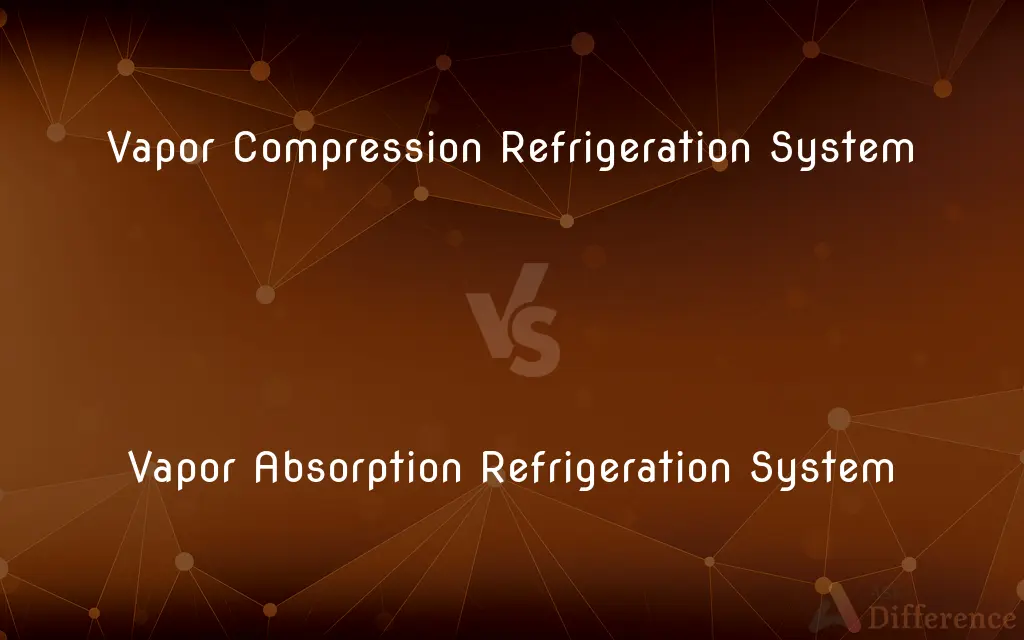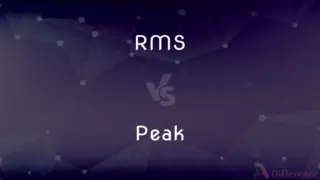Vapor Compression Refrigeration System vs. Vapor Absorption Refrigeration System — What's the Difference?
By Tayyaba Rehman — Published on January 17, 2024
Vapor Compression Refrigeration uses a compressor to cool, while Vapor Absorption Refrigeration uses heat and a solution to absorb and release refrigerant.

Difference Between Vapor Compression Refrigeration System and Vapor Absorption Refrigeration System
Table of Contents
ADVERTISEMENT
Key Differences
The Vapor Compression Refrigeration System operates by compressing a refrigerant, causing it to heat up as it is pressurized. It then passes through a condenser where it cools and liquefies. In contrast, the Vapor Absorption Refrigeration System uses a heat source to boil a refrigerant-absorbent solution, separating the refrigerant as a gas.
In Vapor Compression systems, after condensation, the refrigerant expands and cools down rapidly in an evaporator, absorbing heat from the surroundings and thus providing cooling. Vapor Absorption systems, however, rely on the absorbent to reabsorb the refrigerant after it has evaporated and cooled the surrounding area, then the cycle repeats with heating.
The Vapor Compression Refrigeration System is powered primarily by mechanical energy, typically using an electrically driven compressor. The Vapor Absorption Refrigeration System, however, can be powered by various heat sources, including waste heat or solar energy, making it advantageous in certain situations.
Vapor Compression systems are more common in domestic and commercial refrigerators due to their efficiency and capacity. Vapor Absorption systems are used in industrial applications where waste heat is available or in situations where electrical power is limited or expensive.
To summarize, the main difference between the two systems lies in their driving force (mechanical compressor vs. heat source) and the method of refrigerant circulation (compression and expansion vs. absorption and release).
ADVERTISEMENT
Comparison Chart
Driving Force
Mechanical compressor
Heat source
Energy Source
Electricity for compressor
Heat (solar, waste heat, gas burner, etc.)
Refrigerant Circulation
Compression and expansion of refrigerant
Absorption and release of refrigerant
Common Usage
Domestic and commercial refrigerators
Industrial applications, areas with limited power
Efficiency and Capacity
Generally higher efficiency and capacity
Less efficient, suitable for specific applications
Compare with Definitions
Vapor Compression Refrigeration System
Uses a compressor to increase the pressure and temperature of the refrigerant.
Most air conditioners operate on vapor compression refrigeration principles.
Vapor Absorption Refrigeration System
Less reliant on electricity, often using solar, gas, or waste heat.
For energy conservation, the company installed a vapor absorption refrigeration system.
Vapor Compression Refrigeration System
Relies on an electrically driven compressor for its operation.
The vapor compression refrigeration system in the lab is powered by electricity.
Vapor Absorption Refrigeration System
Commonly used in large-scale and industrial cooling applications.
The chemical factory's cooling requirements are met by a vapor absorption refrigeration system.
Vapor Compression Refrigeration System
A system where the refrigerant undergoes phase changes to absorb and release heat.
The vapor compression system efficiently cycles refrigerant for optimal cooling.
Vapor Absorption Refrigeration System
Suitable for applications where heat is readily available.
The vapor absorption refrigeration system is ideal for remote locations with limited electricity.
Vapor Compression Refrigeration System
A system that cools by compressing and expanding refrigerant.
The household refrigerator uses a vapor compression refrigeration system.
Vapor Absorption Refrigeration System
A refrigeration system using heat to absorb and release refrigerant.
The industrial plant utilizes a vapor absorption refrigeration system for cooling.
Vapor Compression Refrigeration System
A common method for achieving cooling in various appliances.
Commercial freezers typically use vapor compression refrigeration systems for efficient cooling.
Vapor Absorption Refrigeration System
Operates by boiling a refrigerant-absorbent solution to separate and reabsorb refrigerant.
The vapor absorption system in the facility is driven by solar thermal energy.
Common Curiosities
Can Vapor Absorption systems be used for large-scale applications?
Yes, they're often used in industrial settings or large-scale applications.
What energy source does a Vapor Absorption Refrigeration System use?
It uses heat sources like solar, waste heat, or gas burners.
What is the main refrigerant circulation method in Vapor Compression systems?
The refrigerant is compressed and expanded to facilitate cooling.
How do Vapor Absorption systems circulate refrigerant?
Through the absorption and release process using a heat-driven cycle.
What powers a Vapor Compression Refrigeration System?
It's typically powered by an electrically driven mechanical compressor.
Is the Vapor Compression system commonly used in households?
Yes, it's the standard system used in household refrigerators and air conditioners.
Are Vapor Compression systems suitable for remote areas?
They're less suitable if electricity is scarce or unreliable.
What makes Vapor Absorption systems unique?
Their ability to utilize non-electrical heat sources for operation.
Can Vapor Compression Refrigeration Systems be used industrially?
Yes, though they're more common in domestic and commercial settings.
What's a typical use case for Vapor Absorption Refrigeration?
They're often used in areas with limited electricity or abundant waste heat.
Are Vapor Compression systems more efficient than Vapor Absorption systems?
Generally, yes, especially for smaller-scale applications like domestic refrigeration.
Can both systems be used for cooling in buildings?
Yes, but the choice depends on energy availability and cooling requirements.
Is the maintenance of Vapor Absorption systems more complex?
It can be, due to their dependence on heat exchange and chemical processes.
Is electricity required for Vapor Absorption Refrigeration Systems?
Not necessarily, as they can operate on various heat sources.
Do Vapor Absorption systems use a compressor?
No, they do not typically use a mechanical compressor.
Share Your Discovery

Previous Comparison
Akita vs. Shiba Inu
Next Comparison
RMS vs. PeakAuthor Spotlight
Written by
Tayyaba RehmanTayyaba Rehman is a distinguished writer, currently serving as a primary contributor to askdifference.com. As a researcher in semantics and etymology, Tayyaba's passion for the complexity of languages and their distinctions has found a perfect home on the platform. Tayyaba delves into the intricacies of language, distinguishing between commonly confused words and phrases, thereby providing clarity for readers worldwide.
















































